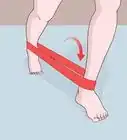This article was co-authored by Shira Tsvi and by wikiHow staff writer, Hunter Rising. Shira Tsvi is a Personal Trainer and Fitness Instructor with over 7 years of personal training experience and over 2 years leading a group training department. Shira is certified by the National College of Exercise Professionals and the Orde Wingate Institute for Physical Education and Sports in Israel. Her practice is based in the San Francisco Bay Area.
There are 17 references cited in this article, which can be found at the bottom of the page.
wikiHow marks an article as reader-approved once it receives enough positive feedback. In this case, 100% of readers who voted found the article helpful, earning it our reader-approved status.
This article has been viewed 143,928 times.
Whether you’re going for a jog or running a long-distance race, controlling your breathing while running is important to build up your stamina and speed. Even though breathing comes naturally, there are a lot of small, simple changes you can make so you don’t run out of breath. Keep reading to learn the proper techniques for breathing on runs so you don’t run out of breath.
Things You Should Know
- Breathe through your nose during gentle jogs and through your mouth during intense runs to get the most oxygen.
- Breathe from your diaphragm. To do this, expand your belly instead of raising your chest when you breathe in.
- Sync your breathing with your footsteps. Try inhaling for 3 steps and exhaling for 2 steps.
Steps
Expert Q&A
-
QuestionIs it better to breathe through your nose or mouth when running?
 Shira TsviShira Tsvi is a Personal Trainer and Fitness Instructor with over 7 years of personal training experience and over 2 years leading a group training department. Shira is certified by the National College of Exercise Professionals and the Orde Wingate Institute for Physical Education and Sports in Israel. Her practice is based in the San Francisco Bay Area.
Shira TsviShira Tsvi is a Personal Trainer and Fitness Instructor with over 7 years of personal training experience and over 2 years leading a group training department. Shira is certified by the National College of Exercise Professionals and the Orde Wingate Institute for Physical Education and Sports in Israel. Her practice is based in the San Francisco Bay Area.
Personal Trainer & Fitness Instructor It's best to inhale through your nose and exhale through your mouth if you can. Use your diaphragm when you breathe and let your stomach inflate when you inhale. This will keep your shoulders up and make it much easier to maintain a good posture and breathing pattern as you run.
It's best to inhale through your nose and exhale through your mouth if you can. Use your diaphragm when you breathe and let your stomach inflate when you inhale. This will keep your shoulders up and make it much easier to maintain a good posture and breathing pattern as you run. -
QuestionI have breathing problem when I am running a mile race. What can I do to get rhythmic control over my breath?
 Michele DolanMichele Dolan is a BCRPA certified Personal Trainer in British Columbia. She has been a personal trainer and fitness instructor since 2002.
Michele DolanMichele Dolan is a BCRPA certified Personal Trainer in British Columbia. She has been a personal trainer and fitness instructor since 2002.
Certified Fitness Trainer Great question. A mile race is considered a short distance. I suggest you focus on your exhale and coordinate it with your foot fall, maybe every second step. The inhale will happen, just exhale as forcefully as you can. It takes a great deal of practice to train your breathing. Try practicing some longer runs to make sure you are in great shape to race a mile.The more running you do, the more your breathing will fall into a pattern.
Great question. A mile race is considered a short distance. I suggest you focus on your exhale and coordinate it with your foot fall, maybe every second step. The inhale will happen, just exhale as forcefully as you can. It takes a great deal of practice to train your breathing. Try practicing some longer runs to make sure you are in great shape to race a mile.The more running you do, the more your breathing will fall into a pattern. -
QuestionHow can I increase my lung capacity for running?
 Michele DolanMichele Dolan is a BCRPA certified Personal Trainer in British Columbia. She has been a personal trainer and fitness instructor since 2002.
Michele DolanMichele Dolan is a BCRPA certified Personal Trainer in British Columbia. She has been a personal trainer and fitness instructor since 2002.
Certified Fitness Trainer Running hills and doing sprints are two great ways to improve your respiratory function in the long-term.
Running hills and doing sprints are two great ways to improve your respiratory function in the long-term.
wikiHow Video: How to Control Breathing While Running
Warnings
- If at any point you feel lightheaded, dizzy, or extremely short of breath, stop running immediately and walk slowly. If you don't feel recovered after 10 to 15 minutes, seek immediate medical attention.[19]⧼thumbs_response⧽
References
- ↑ https://youtu.be/V-2szNtHea4?t=82
- ↑ https://youtu.be/V-2szNtHea4?t=88
- ↑ Shira Tsvi. Personal Trainer & Fitness Instructor. Expert Interview. 7 January 2020.
- ↑ https://www.rush.edu/news/9-tips-healthy-lungs
- ↑ https://sites.udel.edu/coe-engex/2017/04/09/breathe-in-breathe-out-breathing-during-exercise/
- ↑ https://youtu.be/B9ie7aRTCnE?t=275
- ↑ https://www.ncbi.nlm.nih.gov/pmc/articles/PMC4818249/
- ↑ https://my.clevelandclinic.org/health/articles/9445-diaphragmatic-breathing
- ↑ https://my.clevelandclinic.org/health/articles/9450-copd-exercise--activity-guidelines
- ↑ https://www.ncbi.nlm.nih.gov/pmc/articles/PMC4818249/
- ↑ https://www.mayoclinic.org/diseases-conditions/exercise-induced-asthma/symptoms-causes/syc-20372300
- ↑ https://my.clevelandclinic.org/health/diseases/4174-exercise-induced-asthma
- ↑ https://health.clevelandclinic.org/7-tips-to-overcome-asthma-when-you-exercise/
- ↑ https://www.mayoclinic.org/diseases-conditions/exercise-induced-asthma/diagnosis-treatment/drc-20372306
- ↑ Shira Tsvi. Personal Trainer & Fitness Instructor. Expert Interview. 7 January 2020.
- ↑ https://my.clevelandclinic.org/health/articles/9450-copd-exercise--activity-guidelines
- ↑ Shira Tsvi. Personal Trainer & Fitness Instructor. Expert Interview. 7 January 2020.
- ↑ https://www.mayoclinic.org/healthy-lifestyle/fitness/in-depth/exercise/art-20047414
- ↑ https://goaskalice.columbia.edu/answered-questions/it-okay-feel-lightheaded-and-dizzy-after-physical-activity/
About This Article
To control your breathing while running, start by breathing in and out through your mouth rather than your nose, so more oxygen gets to your lungs faster. Then, get up to the speed you want to run, and start counting each step as a beat. Next, synchronize your breathing to your pace, adjusting for speed and intensity. For example, on a moderate run, try inhaling for 2 beats, then exhaling for 2 beats. Alternatively, if your run is more difficult, you can take in more oxygen by inhaling for 3 beats before exhaling for 2 beats. For tips from our Fitness reviewer on how to breathe more efficiently by expanding your belly, read on!












































































Medical Disclaimer
The content of this article is not intended to be a substitute for professional medical advice, examination, diagnosis, or treatment. You should always contact your doctor or other qualified healthcare professional before starting, changing, or stopping any kind of health treatment.
Read More...